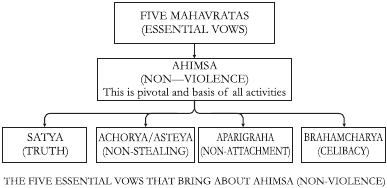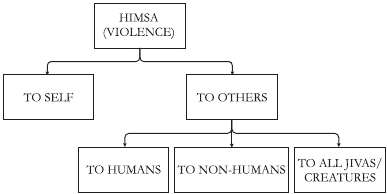In Jain philosophy, significant emphasis is given to the four stages of karma. These include:
- Inflow (the incoming movement) of karma, called Asrava,
- Binding of karma, called Bandha,
- Stoppage of the inflow of karma, called Samvar, and
- Annihilation or destruction of karma, called Nirjara.
All un-liberated (mundane) souls are bound by karmas. The quantity and intensity of the binding and quality of karmas (karmic load) depend upon one’s own actions in life.
Karma can be likened to a dust storm around a house. As soon as the window of the house is opened, the dust particles start coming in. This is asrava or inflow. The quantity, intensity, and quality of incoming dust particles is now controlled by the speed of the incoming particles, how much of the window is open, for how long and whether the window has some kind of wire screen on it or not.
Now the dust particles stick and accumulate onto the floors and walls of the house. This is Bandha, or binding or attachment. After a while the window is closed slightly or completely. Then, the inflow of the dust is either reduced or completely stopped. This is called samvar (stoppage). Now, the owner of the house takes a vacuum cleaner and removes all or some of the dust particles. This is called nirjara (annihilation or destruction), or reducing the karmic load of the particles.
Himsa is the cause of asrava (influx) of papa (bad or sinful) karma and ahimsa is the path to punya (good deeds) and samvar (stoppage of inflow) of karma.
This world (samsara) is comprised of two major entities: living matter (jiva) and nonliving matter (ajiva). The latter has no life at all. In the act of himsa, the perpetrator and the sufferer are always the jiva, not the ajiva, though it’s possible that nonliving matter (ajiva) may be used by the jiva as a means to perform himsa. However, it is certain that, on its own, nonliving matter (ajiva) does not commit himsa, except when assisted by natural forces such as gravity, wind, water, heat, or light, earthquakes, tsunamis, floods, fires, tornadoes, hurricanes, for example, in which jivas may be harmed or killed. The difference between the two is that in natural calamities, the jivas are affected (and hence suffer), but the doer (the earthquake, for example) has no motive or intention to cause pain and suffering to others.
A soul attracts and binds karmas with other souls and living matter only and not with non-living matter (ajiva or pudgal). But in this binding, one may use the help of non-living matter as a means or mechanism to do himsa to one’s self or to other souls. The following diagram shows the mechanism through which one soul (jiva), due to its transactions, attracts and binds karmas with other souls (jivas) only but not with non-living matter (pudgal).

Figure shows “Me” in relationship with others and with those whom I bind karmas
In Jainism, to practice minimum himsa, all sadhus (monks) and sadhvis (nuns) take five great vows, called mahavratas. Similarly, all lay people are advised and supposed to take five small vows, called anuvaratas, plus seven additional vratas (siksha vratas) for a total of twelve vows.
In theory, both mahavratas and anuvratras are the same except a difference in the emphasis on practice of ahimsa. These five vows are: ahimsa (nonviolence), satya (not telling lies), aprigraha (non-possession and non-attachment), achorya (not stealing) and brahamcharya (celibacy). If we look closely at these five vows, we will see that ahimsa is the core of each and also the most fundamental and pivotal vow. The other four are sub-categories and are hence subordinate to the first vow in the practice of ahimsa. Ahimsa is the means - like a boat - to crossing the ocean of samsara. Without the utmost practice of ahimsa, one cannot get rid of accumulated karmas; in fact, one cannot even stop the inflow of new karmas. The other four vows are like the engine, oars, or sails helping the boat move, propelling its progress across the ocean.

For Jains, the guiding slogan and motto is “ahimsa parmo- dharama,” which means that ahimsa is the supreme religion, that is, there is no greater religion than ahimsa.
The following famous aphorism from Jain scriptures sums it all:
“Dhammo mangal mukkittham, ahimsa sanj-mo-tavo, deva vitam naman-santi, jass-dhamme saya mano.”
This means, “that which is nonviolence, self-restraint, and austerity is dharma” (spiritual values). It is by virtue of spiritual values that supreme spiritual beneficence results. To him whose mind is absorbed in spiritual values even gods pay homage (Saman Suttam-82).
In this sutra/aphorism, ahimsa, sanyam (restraint) and tapah (penance) are mentioned as the three most auspicious virtues. Using again the metaphor of ahimsa as a flawless boat sailing smoothly on the water, it is obvious that as soon as himsa is committed, the boat gets a hole in its bottom and starts leaking and accumulating water and thus sinking. As soon as sanyam (restraint) is applied, the occurrence and magnitude of himsa is reduced, the hole starts becoming smaller, and less and less water seeps in. With further restraints (we can imagine applying the brakes fully), the hole in the boat is completely plugged and no more water leaks in. Now, by doing penance (tapah), the accumulated water is thrown out of the boat. Here tapah is like a bucket used to throw away the accumulated water.

PICTURE OF A BOAT, a popular metaphor explaining the cycle of Karmas
In Acarangsutra it is said, “ahimsa is pure and eternal.” The concept of nonviolence is not restricted to human beings but can be embraced by the whole universe. Nonviolence is observed by Jain practitioners as a rule of nature. Abstinence from harming or killing others must be observed in thought, word, and deed. The mere thought of hurting or killing is as immoral as actually killing. Hence, according to Jains, the principle of ahimsa implies purity of thought, word, and deed, actuated by universal love and mercy. There are 106 types of violence, as analyzed in Jainism. What is important to note is that Jain ahimsa is extended equally towards human and sub-human life. Ahimsa reverences not only mankind but all organic life.
There are many terms that define ahimsa—not just nonviolence, but also compassion, not injuring, not hurting, not harming, not interfering, not disturbing, and not killing, as well as the Sanskrit words karuna, anukampa, and daya. But none of these terms come close to defining the magnitude and full impact of ahimsa.
An eminent American professor once commented that the Hippocratic oath, which medical doctors take during graduation, is based on ahimsa. Similarly, the Jain concept of paras-prop-graho-jivanam (all life forms are bound together and dependent on each other for their support) gave rise to the whole ecological movement.
Surely there are hundreds of similar practical, cultural, and philosophical examples showing how Jainism and its philosophy of ahimsa have shaped many traditions and practices in the conduct of business, justice, medicine, and other disciplines.
The spark of himsa starts in the mind, which, if not controlled, becomes a fire in speech and, if still not controlled, becomes an inferno by the time it reaches the stage of action.
It is important to note that while mental himsa affects only oneself, verbal and physical himsa affect both one’s self and others, directly and indirectly.

How himsa (violence) affects self and other living beings
Ahimsa is not only the supreme religion or virtue but is also the only motto or identity of a spiritual person. Without the practice of ahimsa, one cannot be a practitioner of spirituality.
The one who follows ahimsa (including householders and mendicants, sadhu, sadhvi, shravak and shravika) is called ahimsak. An ahimsak not only believes in ahimsa but also actively and proactively practices and lives by ahimsa in his daily living, moment by moment.
Some form of himsa in life is unavoidable. But an ahimsak is always mindful, practices ahimsa with utmost care and due diligence, and strives to find an alternative to minimize himsa continuously, in all circumstances and ways. For an ahimsak, ahimsa is the only way of life and he constantly strives to avoid harm to any living being by thoughts, speech, or actions. Such a code of conduct can then be called the Ahimsak Way of Life, or AWOL.
All jivas (life forms) have in common four essential traits; these include: hunger, reproduction, sleep, and fear. Only humans have the freedom to make a choice of what kind of food to eat (with minimum of himsa) or what kinds of clothing to wear (again, with minmimum of himsa). All nonhuman life forms (jivas who have from one sense up to five senses) don’t have as much freedom of choice. They operate in these four essential areas based on natural instinct and need.
An act of himsa by a jiva can be divided into two categories; the act is either a natural habit, or instinct, such as a carnivorous animal (predators) killing other jiva for food, or a choice, in which the chooser and doer of himsa is generally a human being.
In this samsara, human beings cause the greatest himsa because they choose to cause himsa. They are not required or forced to commit himsa through either habit or natural predisposition. The reason human beings cause himsa for food is that they choose to kill other jivas. Humans also have choice to refrain from killing and thus to live a healthy life by consuming only plant-based foods. Generally, only humans hoard, enslave others, engage in wars, destroy the environment, kill and rape for pleasure, commit assaults, terrorize others, or participate in trafficking of other beings. No other species does such things and thus cause such massive amounts of himsa, all by choice.
Himsa Committed By A Human Agent | ||
| ACTION | HUMAN HARMED? | Non-HUMAN HARMED? |
| To enslave | Yes | Yes |
| Torture | Yes | Yes |
| Human trafficking | Yes | Yes |
| Vivisection in medical and other scientific | Yes | Yes |
| training | ||
| Labor | Yes | Yes |
| Prostitution and sexual assault | Yes | Yes |
| Capital punishment | Yes | Yes |
| Legal penalties; prisons | Yes | Yes |
| Agriculture | Yes | Yes |
| Discrimination based on race, gender, age,religion, or other factors | Yes | No |
| Religious and cultural customs and celebrations | Yes | Yes |
| Genocide | Yes | Yes |
| For food | No | Yes |
| For transport of goods | Some | Yes |
| For medicines | No | Yes |
| For beauty aids | No | Yes |
| For furnishings and decorations | No | Yes |
| For clothing | No | Yes |
| For testing of machines, chemicals | No | Yes |
| Hunting | No | Yes |
| For recreation and entertainment | Some | Yes |
| In wars and battles | Yes | Yes |
| Ingredients in food and chemicals | No | Yes |
| In damage to the environment | Yes | Yes |
| Rodeo, cock and dog fighting, bull runs | No | Yes |
| In the circus | Yes | Yes |
Now that we have established that ahimsa is the most humane and essential part of survival for the human race, we will now examine the history of ahimsa and its foundation.
 Dr. Sulekh Chand Jain
Dr. Sulekh Chand Jain
